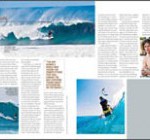 Surf’s Up, Finally Download PDF
Surf’s Up, Finally Download PDF
The world’s first kite competition exclusively for wave-riders debuts.
It wasn’t long ago—perhaps 10 years—when the idea of surfing a wave with a kite was ludicrous. Kites pulled like deranged cruise missiles. Depower was laughable. Getting onto a wave was easy; staying on it was another story. The early generations of kites would stall at low speeds. To keep them aloft, riders needed gobs of speed, which made it impossible to stay on the face of a wave unless the surf was insanely huge (the bigger the swell, the faster it travels). The physics to execute classic moves—bottom turns, off-the-lip carves, and getting barreled—simply didn’t compute. Those who claimed to kite waves were really just outrunning them. Meanwhile, surfers scoffed at the lameness of it all.
But as kiting moved from infancy into adolescence, the desire to catch waves fueled innovation. First came bow kites, in 2005, with hybrid-and delta-shaped sails to follow. The advances led to kites that hovered patiently while a rider dawdled in the surf. Today, kiters are not only shredding the world’s legendary breaks, but doing things paddle-and-wait surfers can only dream of: cherry-picking the sweetest waves in a set—or riding them all—on ordinary surfboards, even strapless.
Watching an accomplished wave-rider is a beautiful sight, a three-way tango with the wind and sea. Even so, the leading kitesurfers are not household names; their notoriety is insular, earned mostly through desultory memes— scintillating photos and videos drifting around the digisphere. The Professional Kiteboard Riders Association (PKRA) tour includes a kitesurfing discipline. But competitors complain that the heats are a halfhearted afterthought, run only when the freestyle has concluded and often in crummy conditions. That’s all about to change when the Kite surf pro (KSP) tour gets underway this year. This first-ever competition dedicated to surf-riding holds its inaugural contest in September on Mauritius at One Eye, a hollow left break renowned for its speed and size. Three weeks later, the tour heads to Peru, where riders will charge the long, chilly waves at Pacasmayo. The last match takes place at Ponta Preta in Cape Verde. With its deep tubes and shallow reef, Ponta Preta will make for a wild and exhilarating grand finale to decide the world champion.
“All three spots are world class,” says KSP vice president and founding member Sky Solbach, a team rider and board designer for north Kiteboarding. “We’ve chosen locations to showcase the sport in the best conditions possible—to demonstrate what can be done with a kite and a surfboard.” each tour stop is allotted seven days, with a potential three-day extension if a big swell s forecast toward the end of the weeklong run. Heats, too, will be lengthy, lasting up to 15 minutes. Kiteboarding champion Kristin Boese, KSP’s president, co-founder, and manager, says, “We are trying to get [participants] to push their riding to the maximum by giving them much longer heats than the PKRA events. Even if they crash, they’ll have enough time to get another few waves in to make up for it.”
Judges will score several factors, including the variety and difficulty of maneuvers and overall speed, power, and flow on the wave. Australian pro kitesurfer Ben Wilson, who is sitting out this year’s tour because of an already packed schedule, helped organizers develop the scoring strategy. Surfing strapless, unhooked, and switch will net participants extra points for technical prowess. “You can ride any way you want, but you still have to fulfill all the criteria,” explains Solbach. “It’s a way to keep it open to everyone.”
At press time, 25 male and a dozen female riders had signed on to compete. Mitu Monteiro, a 28-year-old KSP rider from Cape Verde, was a regular on the PKRA circuit. “But I felt like the conditions for waves weren’t usually very good.” he thinks the choice of sites for the KSP tour will “bring more high-level riders to the competition.” Another KSP participant, 30-year-old Brazilian kiter Guilly Brandão, agrees. “The locations are the biggest draw for me,” he says. “They are places where I would travel to ride anyway, so to be able to compete at these spots is a dream come true for me.”
For the devoted kitesurf fan, traveling to the far-flung tour destinations to attend would be prohibitively expensive. That’s why KSP organizers will stream the action live over their website (kspworldtour.com). “We want to spread it out to millions of people rather than a few hundred sitting on the beach,” says Solbach. Kitesurfing already influences the sport’s evolution— impacting everything from equipment design to riding styles. Yet a pro-level competition that reaches a global audience is bound to ignite an explosion of new interest. As Brandão surmises, “The KSP marks a whole new vision for competitions that will change the way everyone thinks about kitesurfing on the waves.”
Copyright © Michael Behar. All Rights Reserved.
